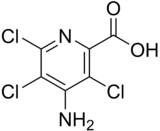Picloram

| |

| |
| Names | |
|---|---|
| IUPAC name
4-Amino-3,5,6-trichloro-2-pyridinecarboxylic acid
| |
| Other names
Picloram
Tordon Grazon | |
| Identifiers | |
3D model (JSmol)
|
|
| Abbreviations | ATCP |
| ChEMBL | |
| ChemSpider | |
| ECHA InfoCard | 100.016.034 |
| KEGG | |
PubChem CID
|
|
CompTox Dashboard (EPA)
|
|
| |
| |
| Properties | |
| C6H3Cl3N2O2 | |
| Molar mass | 241.46 |
| Appearance | Crystalline solid |
| Melting point | 218.5 °C |
Except where otherwise noted, data are given for materials in their standard state (at 25 °C [77 °F], 100 kPa).
| |
Picloram is a systemic herbicide used for general woody plant control, sold under the trade names Tordon and Grazon. It also controls a wide range of broad-leaved weeds, but most grasses are resistant.[1] A chlorinated derivative of picolinic acid, picloram is in the pyridine family of herbicides.
Picloram can be sprayed on foliage, injected into plants, applied to cut surfaces, or placed at the base of the plant where it will leach to the roots. Once absorbed by the foliage, stem, or roots, picloram is transported throughout the plant.
During the Vietnam War, a mixture of picloram and 2,4-D, known as Agent White, was sprayed on plants that survived treatment with Agent Orange (2,4,5-T and 2,4-D). Super-Orange was a mixture of Agent Orange and picloram.
Picloram is of moderate toxicity to the eyes and only mildly toxic on the skin.[1] There is no documented history of human intoxication by picloram so symptoms of acute exposure are difficult to characterize. A possible symptom from massive amounts would be nausea. However, it appears that Picloram was contaminated with up 14% hexachlorobenzene (HCB), a dioxin-like compound and nitrosamines, which are both known carcinogens. Agent White and Super-Orange were proprietary products of the Dow Chemical Company.
Picloram is the most persistent of its family of herbicides.[2] It does not adhere to soil and so may leach to groundwater, and has in fact been detected there. It is degraded in soil and water mainly by microbes. Picloram has very little tendency to accumulate in aquatic life.
Gardeners who use dung as fertilizer should check to make certain that the animal source has not grazed on picloram treated hay, as the dung still has broadleaf killing potency.[3]
References
- ^ a b Picloram Pesticide Information Profile, Pesticide Management Education Program, Cornell University.
- ^ Consumer Factsheet on: PICLORAM, U.S. Environmental Protection Agency.
- ^ Use Caution When Harvesting and Feeding Ditch Hay, U. Minnesota Extension
